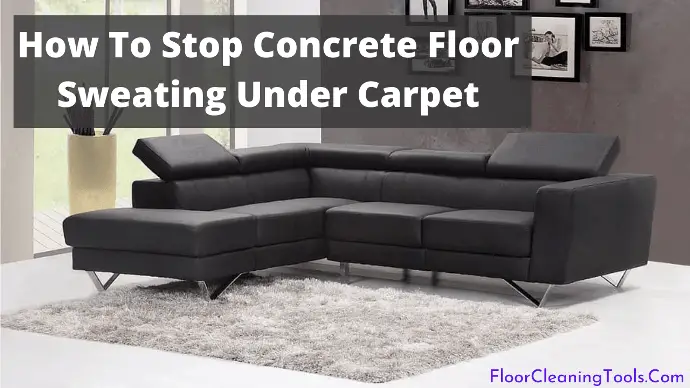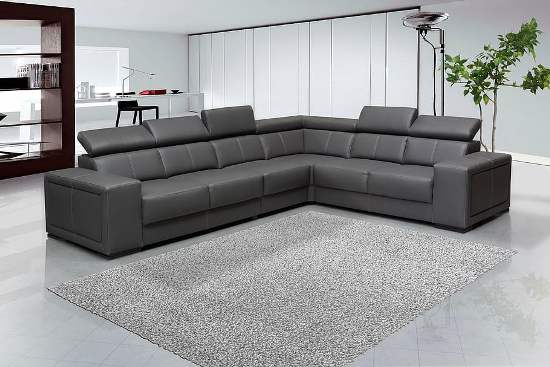The air humidity in my house is considerably high, making my concrete surfaces appear to be dripping with sweat. This condensation of water causes me several irritating problems like slipping or falling incidents.
Even though stopping concrete floor sweating under carpet is not an easy task as other DIY projects, I have eventually succeeded with a lot of effort.
If you are in the same situation but don’t know how to fix it, let’s refer to my methods below. From my valuable experience, I would love to share with you how to prevent concrete coverings from perspiring concrete phenomena. Let’s begin!

Table of Contents
Why Does The Concrete Floor Sweat Under The Carpet?
Several causes are leading to the sweating phenomena of the concrete floor. Below are the principal reasons.
Poor Drainage
If the drainage around the floor is not efficient enough, steam can rise and accumulate on the floor. Even in the case of small rain, rainwater can gather under the carpet on the concrete floor.
Dusty Slabs
Failure to clean the flooring regularly may lead to grime accumulating on the surface, such as dirt, debris, tire marks, and other smudges. That is why the concrete floor cannot absorb moisture or rainwater and cause it to sweat under the carpet.
Dew Point Condensation
It’s the foremost reason for condensation on the concrete floor occurring when humid or warm air meets cooler surfaces under dew point heat. As a result, the floor will sweat under the carpeting, leading to the appearance of moisture.
Low-Quality Sub Concrete Floor
If you don’t preserve the sub-concrete floor properly, it can dampen the main floor. Excessive rainwater can additionally affect because of inadequate subfloor protection.
Besides, applying the improper condensation retarder is the primary reason for this issue. The groundwater will flow into the concrete basement when there is no vapor retarder lying between the subfloor and the ground.
Excessive Floor Treatment
Constantly repairing floors can leave behind excess precipitation. If you ceaselessly use floor treatments, including paints, sealers, or surface densifiers, they may ruin the porousness of the concrete surface.
Moreover, make sure there is no adhesive on the ground before you clean it because this substance will create condensate water and prevent moisture from transpiration.
How To Recognize The Sweating Concrete Floor Under The Carpet?
Unaware of sweating concrete floors might result in bad incidents like slipping. Therefore, you should spot its signs as soon as possible with our identification signs stated below.
- Some damp spots on the concrete floor are turning into darker discoloration.
- The floor surface is getting cracked, lifting, bubbling, or peeling.
- Black stains gradually appear on the ground covering, which causes a moldy smell to your home.
- White residues of alkali or salt arising from the deposition of concentrated mist vapor.
- The concrete floor under the rug is easy to delaminate.
These are the most obvious signs showing that your floor is sweating. Immediately seek methods to detain this bad situation when you see one of these symptoms.
How To Test Sweating Levels Of The Concrete Floor Under Carpet
Before figuring out some method to prevent the dampness on the concrete floor, you should check the sweating levels to have the most proper fix. You can refer to the most common moisture checking below.
Plastic Sheet Test/ASTM D 4263
Take a plastic sheet and stick it on the concrete surface. The purpose is to create a vapor barrier around the plastic sheet. After 72 hours, use a dew point hygrometer to check the sweating level in the air underneath the sheet. The result will show you how much dehydration happened over 72 hours.
Relative Humidity Test/ASTM F 2170
You need to drill a hole into the concrete surface then embed moisture probes in the substrate. The comprehensive and advanced method allows you to measure the volume and presence of moisture content throughout the intensity of the slabs.
Anhydrous Calcium Chloride Test/ASTM F 1896
This test enables you to decide the condensation level over the whole floor surface. With this method, you need to use a closed environment to measure the evaporation amount happening on the concrete ground in a certain period. It’s best to conduct the test in three areas every 1000 square feet from concrete pieces.
First and foremost, pour a packet of anhydrous calcium into a barrel and weigh it. Next, put this container in a certain position on the floor, use a plastic sheet to cover it, and let it stay in place for 72 hours.
Be patient and wait until the required time passes, then take out the containers and weigh them again. The surplus weight shows how much mist the crystals imbibed from moisture emission out of concrete surfaces.
How Dangerous Is A Concrete Floor Sweating Under Carpet?
When your concrete floor under the carpet is sweating, you may encounter some common dangers.
The common incident with sweating concrete surfaces is slipping. Moisture accumulates on the smooth solid covering can be a slipping risk, especially for sealed concrete floors.
That’s because the sealant sticks into the small orifices of the concrete, which moisture cannot penetrate. Consequently, it stays on the surface and makes you slip with only a little amount of water.
Also, humid concrete surfaces are ideal conditions for mold to grow. Mold and mildew are potential jeopardies that can cause several negative effects on health, such as respiratory disease or allergy.
On top of that, the reaction between alkali-silica and moisture can permanently damage concrete floors. This response can lead to some structural problems like severe cracking of the platform.
Likewise, efflorescence is also one of the perils of sweating concrete flooring. This situation occurs when the mist absorbed by concrete materials moves back to the cover and leaves behind white mineral sediments. Bubbling can destroy concrete gradually by evoking minerals from that.
How To Stop Concrete Floor Sweating Under Carpet?

Understanding the difficulties you are going through, we will suggest ways to prevent and improve sweating on concrete floors.
Dry Out The Sweating Concrete Floor
As soon as you discover the phenomenon of floor sweating, you should find ways to dry it asap. You can use a dehumidifier to draw water out. Alternatively, floor fans or ceiling fans can help circulate the air and speed up moisture evaporation.
Another useful tip is to attempt to maintain the temperature of the air and the concrete floor temperature nearly equal.
Good Housekeeping Habits
You should regularly clean and handle the residue, dirt, dust, or excess water on the floor. Continually scrub floors with specialized commercial cleaning detergents to keep floors from becoming too dusty and slippery.
To remove hard-to-reach particles and dirt, use a vacuum to vacuum-clean the floors and appliances in your home.
Seal Concrete Floors
If possible, you should seal the concrete surfaces to retain moisture with a permeable sealant. For the best protecting effect, you’d better coat a strong thickener sealer on the surfaces, then cover it with a stain-resistant layer. This technique will assist you in stopping condensation issues.
Don’t forget to seal all the edges and corners of the concrete floor, where cracks can easily allow damp to flow and mold to spread out.
Invest Dehumidification Units
You have made use of ceiling fans or floor fans, but the moisture content in your atmosphere is still relatively high; you should invest in some dehumidification units. Though these types of equipment are expensive, they can work well in reducing or eliminating excess moisture accumulating on concrete surfaces.
Do Moisture Tests
After you apply some methods recommended above, let’s check the dampness of the floor once more for sure. When it comes to moisture test techniques, we have already guided you in the above part. Let’s scroll up for more details.
In case your concrete floor is still sweating, one by one, implement the preceding process again, and you are sure to succeed.
Wrapping Up
After referring to my techniques on How to Keep Concrete Floors from Sweating Under Carpet, I believe you have figured out various useful ways. I have succeeded in this aspect, and so you will be victorious too.
To accomplish this challenge, I advise you to maintain good housekeeping habits usually. Moreover, overlaying your concrete landing with a primer finish would be a wise investment for long-term purposes.
Related Post:
- Is AdvanTech Flooring Waterproof? – Answer as Desired
- How To Remove Glued Down Carpet Pad From Concrete – Detail Instruction
- How To Remove Wood Stain From Concrete – Problem Solved!
- Things You Should Know: Pros And Cons Of Sealing Concrete Driveway

My carpet in the house is suddenly really wet, especially an area next to the wall in a corner. The carpet is directly on concrete, and we had some very cold weeks (32F) in the night. Does condensation explain the wetness? I checked the water meter outside, and when all faucets inside turned off, it did not detect any water usage (I spent 3 hours between readings). The carpet was damp occasionally before, usually during the summer, but now its really wet.